Get out the No-Doz!No, wait. Maybe some of you non-geologist types might want to take your chances and just fall asleep when you find out what this blog post is about. Or perhaps there is a sock drawer that needs rearranging, or a refrigerator that needs defrosting, or a roof that needs reshingling. Something! Anything! Anywhere! Isn’t there anything else you can find to do besides read about my favorite subject?
And what is that subject? You guessed it – GEOLOGY!!!
Ah, but… This is what I’m all about. I can’t help it! Sadly, I was told that in a recent blog on rhyolite I had probably lost 95% of my audience. Please – tell me it isn’t true!
In my opinion (and it is my blog, after all) there is nothing quite as exciting as rocks nearly 1.8 billion years old, surrounded by other rocks even older. Over countless millennia the crust of the Earth has been subducted and sheared, lifted, tilted, thrust forward, stretched back, and otherwise undergone all sorts of tectonic gymnastics so that what we have here and now is my backyard – the Colorado Plateau/Great Basin transition zone of southwestern Utah, southeastern Nevada, and northwestern Arizona with its mind-bending scenery of jagged mountains, elongated valleys, stair-stepping plateaus, and endless vistas.
By now you might be asking (if you don’t already have your head stuck in the freezer, hacking away at a 7-inch thick block of ice with a butter knife) “Where are these exotic rocks? Can I see them?”
When I was in school studying geology I went on every single field trip I could fit into my schedule. I also spent a lot of time, nearly 3 years, studying these very ancient rocks found in the Beaver Dam and Virgin Mountains outside of St. George, UT. And I still go out there because of the fascination these rocks hold for me. This past weekend was no exception as I tagged along on a 3-day SUU field trip with Mark, my old professor, and a group of his current students. I did not have to take notes, I would not be quizzed, and I left the driving to someone else. I went along for the sheer joy of seeing the rocks.
I have inserted lines and boxes in some of the photos in order to better visualize some of these really cool structures. Click on the pic and it will enlarge. Enjoy!
 Garnets in schist, Beaver Dam Mtns.
Garnets in schist, Beaver Dam Mtns. Folded rocks – dark lines show layers tilted in opposite directions, Beaver Dam Mtns.
Folded rocks – dark lines show layers tilted in opposite directions, Beaver Dam Mtns.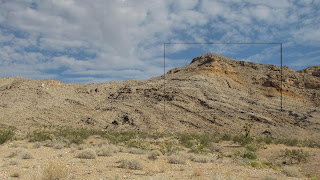 Ramp (a type of thrust) fault, Beaver Dam Mtns.
Ramp (a type of thrust) fault, Beaver Dam Mtns.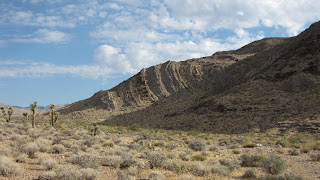 Overturned beds, Beaver Dam Mtns.
Overturned beds, Beaver Dam Mtns.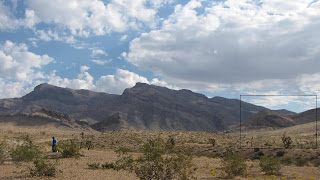 Isoclinal (tight) fold, Beaver Dam Mtns.
Isoclinal (tight) fold, Beaver Dam Mtns.
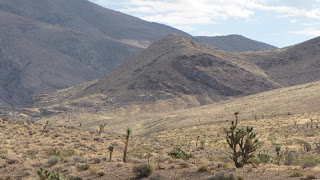
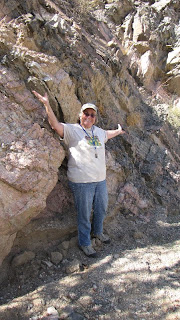 Yours Truly at sheared ultramafic darker “pods” (from deep in the mantle) , Virgin Mtns.
Yours Truly at sheared ultramafic darker “pods” (from deep in the mantle) , Virgin Mtns.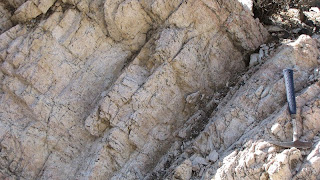 Sheared garnets in leucogranite intrusion, Virgin Mtns.
Sheared garnets in leucogranite intrusion, Virgin Mtns.
For my non-geologist friends: think white melted rocks with stretched garnets!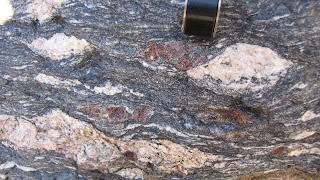 Sheared garnets (red) and sillimanite (small white) minerals in schist, Virgin Mtns.
Sheared garnets (red) and sillimanite (small white) minerals in schist, Virgin Mtns.
Check out the sense of shear and plastic flow of the minerals. 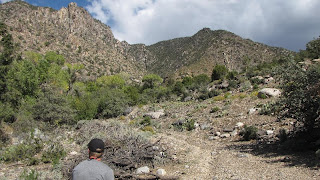 Shear zone, Virgin Mtns.
Shear zone, Virgin Mtns.
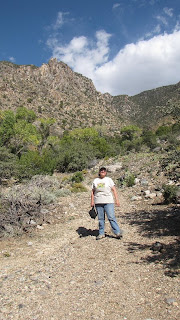
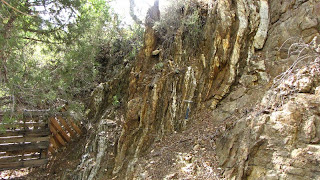 Shearing up close and personal, Virgin Mtns.
Shearing up close and personal, Virgin Mtns.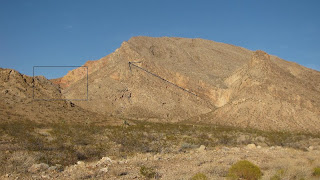 Thrusting (from tectonic compression of crust) where older Permian limestones (240 million years old) are thrust over younger Navajo Sandstone (in box), Virgin Mtns.
Thrusting (from tectonic compression of crust) where older Permian limestones (240 million years old) are thrust over younger Navajo Sandstone (in box), Virgin Mtns.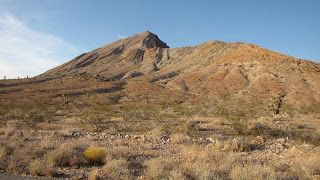 Overthrust bedds of Permian limestones.
Overthrust bedds of Permian limestones. Camping beneath the Aztec Sandstone, NV (same as Navajo Sandstone in Utah/Zion NP)
Camping beneath the Aztec Sandstone, NV (same as Navajo Sandstone in Utah/Zion NP) 240-million year old Permian limestones on left, Virgin Mtns. in back ground
240-million year old Permian limestones on left, Virgin Mtns. in back ground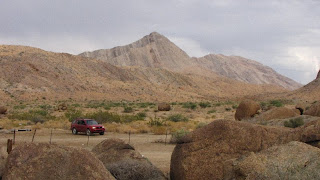 Tilted beds, Gold Butte area, Virgin Mtns. Rocks in foreground are a 1.4-billion year old megacrystic (really big!) granite.
Tilted beds, Gold Butte area, Virgin Mtns. Rocks in foreground are a 1.4-billion year old megacrystic (really big!) granite.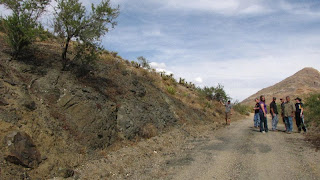 Ultramafic “pod” of dark mantle rock.
Ultramafic “pod” of dark mantle rock.



